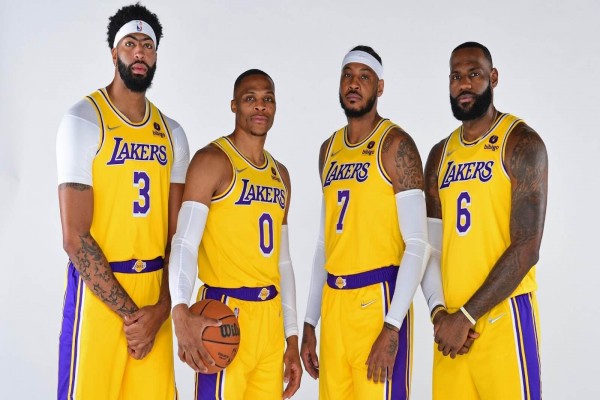Looking back at the origins of the Lakers club and how its history began

Stories about the Lakers club
American leagues-and the NBA is no exception-are built on a philosophy of equality. The salary cap, the draft system, the strict control of various bodies, and the lack of imbalance in the board of directors suggested a sports organization in which even genius management does not guarantee any lasting dominance. Even if one manages to assemble the best team, its shelf life is always minimal - because of the contract structure, the impossibility of rejuvenation, and the grueling rhythm of tournaments.
Competition here exists only on the level of talent (managers and players), not on the level of cash infusions. And what is impossible in this rigid framework is what exists in European soccer - the existence of super clubs that can regularly allow enormous spending because they earn more than others (or even because they are sitting on an oil well). Even in casinos online India has games NBA theme - is this not a sign of high popularity?
In the NBA, everyone is equal, though not to the fullest extent.
Some teams want to shut down - because they live on Louisiana swamps or in frozen forests and don't generate much enthusiasm for the working population. And then there are the teams that make the most money, even their general managers for decades thinking only about how to feng shui the stationery on the desk. It has been called the problem of large and small markets: Clubs from America's major cities have an advantage in player promotion, which should seem to extend to the court. But for some reason, it doesn't.
In 72 seasons, the Lakers:
-
They were NBA champions 17 times.
-
Thirty-two times reached the Finals.
-
Reached the playoffs 61 times.
-
Won 60% of their regular season games.
-
Won 60% of their games in the playoffs.
-
Won 450 playoff games (more than anyone else).
It became the worst to get Mikan
The man who built the Lakers' first dynasty was Sid Hartman, a Star Tribune sports journalist.
His greatest asset was a notebook where you could find the names of almost every more or less famous coach in the country. He kept friendships with all of them and - in his own words - sent about 500 Christmas cards every year.
In the '40s, Hartman could not travel all over the country and look for players. Nor could he watch them on video.
But he had all the information he needed on hand.
For example, thanks to a recommendation from one of his coach friends, he tracked down one of the stars of that team - Jim Pollard, a hyper-athletic (for the postwar era) forward who allegedly put up from the top, pushing from the free-throw line - in an amateur league.
But Hartman's main stratagem consisted of a rough calculation.
When he convinced businessman Ben Berger that he vitally needed his own sports team, he chose several options.
One of them was the Chicago Giers, where George Mikan had made his debut by then: the center was already in his first season, recommended as affordably as possible - he helped the club from his native Illinois take the World Basketball Tournament and became its MVP.
But acquiring Chicago would have meant developing other players on contract and cost much more.
Instead, for $15,000, Hartman picked up the Detroit Jams, the worst club in the NBL at the time. The amount was paid solely for a place in the league and the previous season's performance; the Jams had nothing else of interest, not even shabby goals.
But when Chicago closed (and Hartman knew it was imminent), the heirs of the Jams - thanks to their failure the previous year - had the best chance to sign Mikan.
The unassuming bespectacled, 5'9" tall man proved to be the first revolutionary figure for basketball. He broke into a game designed for little ones and left no one in the way: once he got the ball near the rim, no one could stop him. Mikan is the first player who forced the league to revisit the rules: first increasing the paint and then instituting a 24-second clock. At a super-slow tempo (on his way to the basket, he also had time to look at his bench, where they wiped his glasses with sweat) and unlimited access under the basket, the first dominant center carried everyone.
But when Chicago closed (and Hartman knew it was imminent), the heirs of the Jams - thanks to their failure the previous year - had the best chance of signing Mikan.
The unassuming bespectacled, 5'9" tall man proved to be the first revolutionary figure for basketball. He broke into a game designed for little ones and left no one in the way: once he got the ball near the rim, no one could stop him. Mikan is the first player who forced the league to revisit the rules: first increasing the paint and then instituting a 24-second clock. At a super-slow tempo (on his way to the basket, he also had time to look at his bench, where they wiped his glasses with sweat) and unlimited access under the basket, the first dominant center carried everyone.
But by the time they figured out how to limit him, the Lakers had already won one NBL title and five more NBA titles (47-54) and only gave up a trophy in one season when Mikan was running around with a cracked leg.
Were the worst and richest to assemble the best team of the era
After Mikan left, the Lakers did just one stupid thing, but a pretty big one: they traded star forward Clyde Lovlett for a first-round pick to pick up super-popular Hot Rod point guard Hundley.
Hundley is Pete Maravich before Pete Maravich, a white showman who can't take a step without throwing out some pass from behind or other wildness. But he was just as spectacular off the court: regular regime violations, his first attempts to closely associate the NBA and sex with a record-setting performance, and the ever-present alcohol limited the youngster's league career to six seasons, albeit unforgettable ones.
The dominance-pampered audience in Minneapolis stopped going to the Lakers after Mykan left. And the team went down for the high picks.
And it did so - albeit unintentionally - very effectively.
In '58, the Lakers selected Elgin Baylor, the first forward in the NBA to turn basketball into a good sport, at number one. Baylor had been on fire since his first season but had to serve a stint simultaneously, which is why the Lakers were both making it to the Finals and having their worst regular season performance.
So the Lakers were not limited to one star.
In '60, they again had their worst year and the second draft pick. Under that pick was Jerry West, a maniacally obsessed with winning and self-improvement guard. He never figured out why he needed to win (because he wasn't particularly good at it), but his obsession pushed him to the kind of self-torture that few people could.
Around two players at once who claimed to be the best of their era, the Lakers built another sort of dynasty. "Sort of," because this time, they regularly reached the Finals -- ten times from '59 to '73 -- and just as regularly lost there to Boston with Bill Russell.
An essential element of success came from an unaccounted-for, new club specificity.
"The Lakers had a change of venue in '58. But the novelty effect did not work in L.A. The move failed to attract fans; the club barely drew 2,000 spectators, and there was no way to get on NBA TV.
That all changed in '62. "The Lakers were in a seven-game winning streak with the Celtics, and the final games were televised by Chick Hearn, the legendary sportscaster for California at the time. Unfortunately, the finale ended in tragedy - Frank Selvey could have put down the winning shot, but something went wrong. However, as the series progressed, the Los Angeles audiences appreciated the new team-the. First Hollywood stars had already appeared at the games, attendance soared to 15,000 spectators, and the Lakers became the league's richest club.


